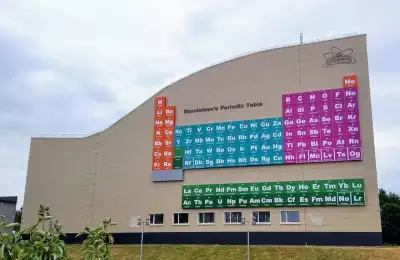 Salixinto, CC BY-SA 4.0, via Wikimedia Commons
Salixinto, CC BY-SA 4.0, via Wikimedia Commons
Periodic Table Quiz
How much do you know about the symbols of the periodic table?
Welcome to the Periodic Table Symbols Quiz! This engaging quiz is designed to test your knowledge and help you learn the symbols of the elements in the periodic table. Challenge yourself and discover how well you can identify and recall the symbols of various elements.
Due to its extensive content, the Periodic Table Symbols Quiz is divided into five parts, making it easier for students to keep track of their progress and reinforce their understanding of the elements that require more attention.
This is the 1st part of the periodic table quiz, and it covers questions about elements with atomic numbers 1 to 25. Let's begin and see how many symbols you can master!
Part 1 / Part 2 / Part 3 / Part 4 / Part 5
Start the Periodic Table quiz
Questions and answers about Periodic Table (Part 1)
-
What symbol represents hydrogen?
Hydrogen is a chemical element with atomic number 1 and symbol "H", which means that each hydrogen atom has a proton in its atomic nucleus. It is the lightest and most abundant element in the universe.
- H
- He
- Hi
- Hy
-
What symbol represents helium?
Helium is a chemical element with atomic number 2 and symbol "He". It is a colorless, odorless, and tasteless gas. Helium is the second lightest and second most abundant element in the universe.
- H
- He
- Hl
- Hm
-
What symbol represents lithium?
Lithium is a chemical element with atomic number 3 and symbol "Li". It is a soft, silvery-white alkali metal. Lithium is the lightest metal and has a wide range of applications, including in batteries and medications.
- Lm
- Lh
- Li
- Lt
-
What symbol represents beryllium?
Beryllium is a chemical element with atomic number 4 and symbol "Be". It is a hard, steel-gray metal that is lightweight and brittle. Beryllium has a high melting point and is used in various industries.
- By
- B
- Be
- Br
-
What symbol represents boron?
Boron is a chemical element with atomic number 5 and symbol "B". It is a metalloid with properties intermediate between those of metals and nonmetals. Boron is commonly used in the form of borax and boric acid.
- Bn
- Bo
- B
- Be
-
What symbol represents carbon?
Carbon is a chemical element with atomic number 6 and symbol "C". It is a nonmetallic element and the basis of organic chemistry. Carbon is present in all known living organisms and is a key component of many important compounds.
- C
- N
- O
- Ca
-
What symbol represents nitrogen?
Nitrogen is a chemical element with atomic number 7 and symbol "N". It is a diatomic nonmetal gas that makes up about 78% of Earth's atmosphere. Nitrogen is essential for many biological processes and is widely used in various industrial applications.
- Ni
- N
- Ng
- Nt
-
What symbol represents oxygen?
Oxygen is a chemical element with atomic number 8 and symbol "O". It is a highly reactive nonmetal that is essential for sustaining life. Oxygen is the most abundant element in the Earth's crust and plays a critical role in various biological and chemical processes.
- HO
- Ox
- O
- O2
-
What symbol represents fluorine?
Fluorine is a chemical element with atomic number 9 and symbol "F". It is a pale yellow, highly reactive gas belonging to the halogen group. Fluorine is the most electronegative element and is used in various industrial applications, particularly in the production of fluoropolymers.
- Fl
- Fu
- F
- Fr
-
What symbol represents neon?
Neon is a chemical element with atomic number 10 and symbol "Ne". It is a noble gas that is colorless, odorless, and inert. Neon is used in lighting applications, such as neon signs, and is also used in cryogenic refrigeration.
- No
- Nn
- N
- Ne
-
What symbol represents sodium?
Sodium is a chemical element with atomic number 11 and symbol "Na". It is a highly reactive metal that is soft and silver-white in appearance. Sodium is an essential element for various biological processes and is commonly found in table salt and many other compounds.
- So
- Na
- S
- Mg
-
What symbol represents magnesium?
Magnesium is a chemical element with atomic number 12 and symbol "Mg". It is a shiny gray metal that is relatively reactive. Magnesium is an important element for living organisms and is involved in various biochemical reactions. It is also commonly used in alloys and as a component of fireworks.
- Ma
- Mn
- Mg
- Al
-
What symbol represents aluminum?
Aluminum is a chemical element with atomic number 13 and symbol "Al". It is a silvery-white, lightweight metal that is highly malleable. Aluminum is widely used in various industries, including construction, transportation, and packaging. It is known for its low density and corrosion resistance.
- Aa
- Am
- Al
- Au
-
What symbol represents silicon?
Silicon is a chemical element with atomic number 14 and symbol "Si". It is a hard, brittle crystalline solid with a blue-gray metallic luster. Silicon is widely used in the production of semiconductors, ceramics, and various electronic devices. It is a fundamental element in the field of modern technology.
- Sl
- S
- Si
- Sn
-
What symbol represents phosphorus?
Phosphorus is a chemical element with atomic number 15 and symbol "P". It exists in several forms, including white, red, and black phosphorus, with different properties and uses. Phosphorus plays a vital role in biological processes and is an essential element for life. It is used in the production of fertilizers, detergents, and various industrial chemicals.
- F
- Ph
- P
- Fo
-
What symbol represents sulfur?
Sulfur is a chemical element with atomic number 16 and symbol "S". It is a yellow, brittle solid that is commonly found in nature as a mineral. Sulfur is used in various industrial processes, including the production of fertilizers, chemicals, and rubber. It is also an important element in the Earth's biogeochemical cycles.
- Su
- So
- S
- Se
-
What symbol represents chlorine?
Chlorine is a chemical element with atomic number 17 and symbol "Cl". It is a pale yellow-green gas with a strong odor. Chlorine is widely used as a disinfectant and in the production of various chemicals, including plastics and solvents. It is an essential element for maintaining proper sanitation and water safety.
- Co
- Ch
- Cl
- Ca
-
What symbol represents argon?
Argon is a chemical element with atomic number 18 and symbol "Ar". It is a colorless, odorless gas that is present in the Earth's atmosphere in small amounts. Argon is used in various applications, including welding, lighting, and as a protective gas in certain industrial processes. It is also used in scientific research and has some medical applications.
- Ag
- An
- Ar
- Ao
-
What symbol represents potassium?
Potassium is a chemical element with atomic number 19 and symbol "K". It is a soft, silvery-white metal that is highly reactive. Potassium is an essential element for living organisms and is involved in various physiological processes. It is commonly found in bananas, potatoes, and other fruits and vegetables.
- P
- Kp
- K
- Ca
-
What symbol represents calcium?
Calcium is a chemical element with atomic number 20 and symbol "Ca". It is a soft gray metal that is essential for the development and maintenance of bones and teeth in humans and other animals. Calcium is also involved in muscle contraction, blood clotting, and various cellular processes. It is commonly found in dairy products, leafy greens, and other foods.
- Cl
- C
- Ca
- Co
-
What symbol represents scandium?
Scandium is a chemical element with atomic number 21 and symbol "Sc". It is a silvery-white metal that is relatively soft and lightweight. Scandium is used in certain alloys and as a component in some high-performance sports equipment. It also has applications in the aerospace industry and in the production of certain types of lamps.
- Sa
- Sd
- Sc
- Si
-
What symbol represents titanium?
Titanium is a chemical element with atomic number 22 and symbol "Ti". It is a strong, lustrous metal that is resistant to corrosion. Titanium is widely used in various industries, including aerospace, automotive, and medical. It is valued for its high strength-to-weight ratio, excellent biocompatibility, and resistance to extreme temperatures.
- Ta
- Tt
- Ti
- Tn
-
What symbol represents vanadium?
Vanadium is a chemical element with atomic number 23 and symbol "V". It is a hard, silvery-gray metal that is primarily used as an additive in the production of steel. Vanadium is known for its high strength, low corrosion rate, and ability to form alloys with other metals. It also has some applications in the energy storage industry.
- Vn
- Vd
- V
- Va
-
What symbol represents chromium?
Chromium is a chemical element with atomic number 24 and symbol "Cr". It is a hard, lustrous metal that is commonly used in various industrial applications, including the production of stainless steel and as a coating for other metals. Chromium compounds are also used in dyes, pigments, and tanning processes.
- Cm
- Ch
- Cr
- Cn
-
What symbol represents manganese?
Manganese is a chemical element with atomic number 25 and symbol "Mn". It is a grayish-white metal that is commonly found in nature as a mineral. Manganese is primarily used in the production of steel as a deoxidizing and desulfurizing agent. It is also an essential nutrient for humans and other organisms.
- Ma
- Mg
- Mn
- Mh
 Periodic Table Quiz
Periodic Table Quiz
Part 1 / Part 2 / Part 3 / Part 4 / Part 5
How many elements are on the periodic table?
The periodic table is a comprehensive and organized chart that encompasses all the known chemical elements. The periodic table consists of 118 confirmed elements, however note that this number may change over time as new elements are discovered or synthesized through scientific research.
These elements are arranged in a specific order based on their atomic number, which represents the number of protons found in the nucleus of an atom of that element. The periodic table is divided into rows called periods and columns called groups. The elements within a group share similar chemical properties, while those within a period typically exhibit recurring trends in their physical and chemical characteristics.
The periodic table provides crucial information about each element, including its atomic symbol, atomic mass, and electronic configuration. The atomic symbol is a unique abbreviation used to represent an element. For example, H represents hydrogen, O represents oxygen, and Au represents gold.
The first element on the periodic table is hydrogen, which has an atomic number of 1. It is followed by helium with atomic number 2. The heaviest naturally occurring element is uranium, which has an atomic number of 92. Elements with higher atomic numbers beyond uranium are typically synthetic and are created in laboratories through nuclear reactions.
It's worth mentioning that some elements on the periodic table have temporary names and symbols, such as ununtrium (Uut) for element 113, ununpentium (Uup) for element 115, and so on. These temporary names and symbols are assigned until a permanent name and symbol are approved by the International Union of Pure and Applied Chemistry (IUPAC).
Overall, the periodic table is a fundamental tool in the field of chemistry, providing scientists with a systematic framework to understand the properties, behavior, and relationships of different elements in the universe.